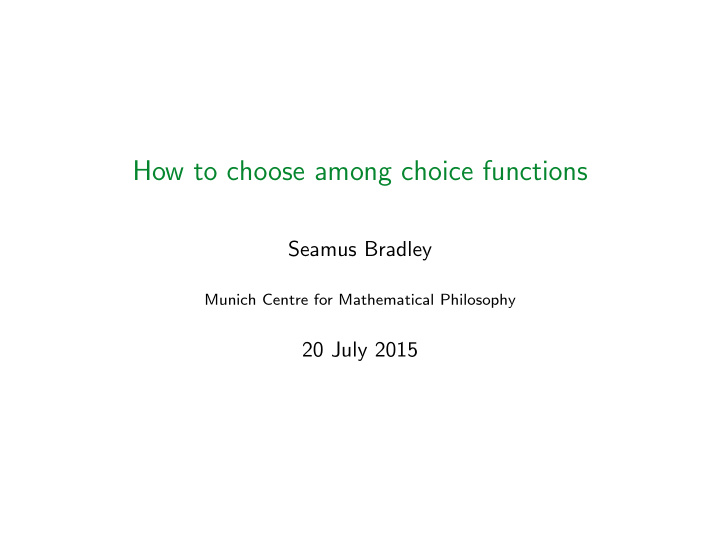



How to choose among choice functions Seamus Bradley Munich Centre for Mathematical Philosophy 20 July 2015
Core idea We are interested in rational decision making where the agent is represented as having a set of probability functions P for her degrees of beliefs, or credences. The main question is: what can we say about rational choices?
Core idea We are interested in rational decision making where the agent is represented as having a set of probability functions P for her degrees of beliefs, or credences. The main question is: what can we say about rational choices? We describe some popular “choice functions”, explore what properties they have, and whether these properties are rationally compelling. We also explore the question of how to interpret the choice function.
Basics ◮ We have a (finite) state space Ω. ◮ We have a set of gambles Φ which are functions from Ω to R . ◮ For p ∈ R let p ϕ + (1 − p ) ψ be the “mixed act” defined pointwise, and let p ϕ + (1 − p ) A be the set of acts in A mixed with ϕ . ◮ A ∗ is the set of mixed acts over acts in A . ◮ The agent has a set of probability functions P from Ω to [0 , 1]. ◮ Expectations for pr ∈ P defined by E p ( ϕ ) = � ω ∈ Ω pr ( ω ) ϕ ( ω ). ◮ Expectations for imprecise agents: E ( ϕ ) = { E pr ( ϕ ) , pr ∈ P} . ◮ Summary functions P ( X ) = inf P ( X ) and P ( X ) = sup P ( X ) likewise for E . ◮ For A ⊆ Φ let C ( A ) be the set of choiceworthy acts.
Interpreting C Strong ϕ ∈ C ( A ) means ϕ is among the best and exactly as good as all other ψ ∈ C ( A ).
Interpreting C Strong ϕ ∈ C ( A ) means ϕ is among the best and exactly as good as all other ψ ∈ C ( A ). Weak ϕ ∈ C ( A ) means ϕ is better than all acts not in C ( A ).
Interpreting C Strong ϕ ∈ C ( A ) means ϕ is among the best and exactly as good as all other ψ ∈ C ( A ). Weak ϕ ∈ C ( A ) means ϕ is better than all acts not in C ( A ). Very Weak All we can say is that the best act is among the ϕ ∈ C ( A ).
Maximality The maximal set for a relation � is M � : M � ( A ) = { ϕ ∈ A : ¬∃ ψ ∈ A , ψ ≻ ϕ }
Expectation relations We define the following two relations: ϕ � E pr ψ iff E pr ( ϕ ) ≥ E pr ( ψ ) � � Dom = � E pr P
Choice functions Maximin M E
Choice functions Maximin M E Maximality M � Dom
Choice functions Maximin M E Maximality M � Dom E-admissibility L ( A ) = � pr ∈P M � E pr ( A )
Properties of choice Nondomination C satisfies � Dom . Contraction Consistency C ( A ∪ B ) ⊆ C ( A ) ∪ C ( B ). (Sen’s alpha) Independence C ( pA + (1 − p ) ϕ ) = p C ( A )(1 − p ) ϕ Union Consistency C ( A ) ∩ C ( B ) ⊆ C ( A ∪ B ). (Sen’s gamma) All-or-Nothing If ϕ ∈ C ( A ) but ϕ / ∈ C ( B ) then, for all ψ ∈ C ( A ) we have ψ / ∈ C ( B ). (Sen’s beta) Mixing C ( A ) ⊆ C ( A ∗ ). Convexity C ( A ) ∗ ∩ A = C ( A ).
Conclusions ◮ Maximin ( M E ) violates Independence and Nondomination (though it never chooses strictly dominated acts).
Conclusions ◮ Maximin ( M E ) violates Independence and Nondomination (though it never chooses strictly dominated acts). ◮ Maximality ( M � Dom ) violates All-or-Nothing, Mixing and Convexity.
Conclusions ◮ Maximin ( M E ) violates Independence and Nondomination (though it never chooses strictly dominated acts). ◮ Maximality ( M � Dom ) violates All-or-Nothing, Mixing and Convexity. ◮ E-admissibility ( L ) violates Nondomination, Union Consistency, All-or-Nothing and Convexity.
Conclusions ◮ Maximin ( M E ) violates Independence and Nondomination (though it never chooses strictly dominated acts). ◮ Maximality ( M � Dom ) violates All-or-Nothing, Mixing and Convexity. ◮ E-admissibility ( L ) violates Nondomination, Union Consistency, All-or-Nothing and Convexity. ◮ Levi’s two-tiered security conscious choice rule M E ◦ L violates Nondomination, Independence, Contraction Consistency and Union Consistency.
Conclusions ◮ Maximin ( M E ) violates Independence and Nondomination (though it never chooses strictly dominated acts). ◮ Maximality ( M � Dom ) violates All-or-Nothing, Mixing and Convexity. ◮ E-admissibility ( L ) violates Nondomination, Union Consistency, All-or-Nothing and Convexity. ◮ Levi’s two-tiered security conscious choice rule M E ◦ L violates Nondomination, Independence, Contraction Consistency and Union Consistency. ◮ One can compose E-admissibility and Maxmin with Maximality to avoid nondomination, but all the other problems remain.
Further work ◮ Sequential choice?
Further work ◮ Sequential choice? ◮ Value of information?
Further work ◮ Sequential choice? ◮ Value of information? ◮ A “regret-based” rule?
Recommend
More recommend